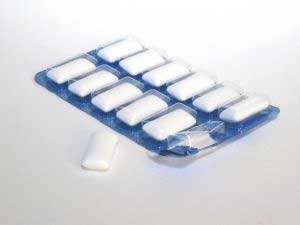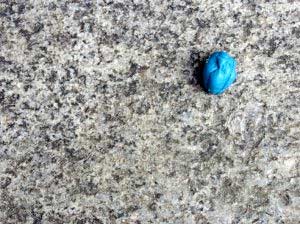Chewing gum, the most popular snack in America, can be traced back to ancient Greece. Over the past two centuries, gum manufacturers have embraced materials science to produce a product that has a wide variety of benefits, from cavity protection to enhanced mental concentration. However, this treat is also polluting streets, sidewalks, and buildings around the world. In an effort to solve this problem, engineers have employed amphiphilic polymers to develop a “low-adhesion” chewing gum that can be easily removed from surfaces, offering a more environmentally-friendly product. This innovative technology can help save millions of dollars in clean-up costs and be applied to other markets, including personal care products, paints, and coatings.
Introduction
A relaxing stroll in the park can instantly turn into an unpleasant experience when you step on that sticky, saliva-soaked piece of gunk on the pavement. No matter how much you curse, scrape, and peel, it seems to be stuck on the sole of your shoe forever (see Fig. 1). Why is this piece of gum so difficult to remove? For years, engineers wondered the same thing.
Equipped with a new understanding of materials science, the study and application of properties of matter, researchers at the University of Bristol in England have developed a solution to the messy problem of gum pollution. Their invention of “Clean Gum” signifies a major leap in an industry that stretches across the globe.
A Brief History of Chewing Gum
Chewing gum was named the number one snack choice by Americans in 2005 [1]. It was first used in ancient Greece as an edible treat made from mastiche, a chewy tree sap, and has since evolved into an indigestible confection that people grind their teeth on to freshen their breath after meals, focus during an exam, or even curb their appetite at work. Over the years, gum makers replaced spruce-sap gum bases with petroleum-derived paraffin wax. Despite the increased flavor and sweetness of paraffin gums, they lacked the soft texture or “chewiness” of sap-based gums [2].
In the 1870s, American inventor Thomas Adams began experimenting with chicle, a sticky substance found in the sapodilla tree. He tried using the rubbery sap to make rain boots, toys, and masks before he realized that the adhesive properties of chicle made it a poor substitute for rubber. Frustrated with his failed attempts, he popped a piece of chicle in his mouth and began chewing on a new idea. With the help of his sons, Adams heated the chicle with sugar and decided to turn their creation into a new product. In the following months, he founded Adams Sons & Co. and the first chewing gum factory in the world and began producing flavored gum made from sapodilla tree sap [3].
After World War II, engineers developed gum bases that used synthetic polymers instead of the naturally occurring bonds in tree sap. These man-made rubbers have the same elastic characteristics of chicle, but are less expensive to manufacture and do not require the widespread tapping of trees. The use of synthetic polymers in chewing gum signified a major breakthrough in materials science and chemical engineering.
Today, the average American chews 300 sticks or 1.5 pounds of gum per year [1]. Spurred on by popular demand, gum makers are constantly improving their products by optimizing “chewiness,” retaining flavor, and enhancing texture. They have developed practical gums that help reduce nicotine cravings, protect teeth, and even deliver caffeine, vitamins or therapeutic drugs.
What Is On The Label?
If you look on the package of any commercial chewing gum, you will notice three main ingredients: gum base, sweetener, and artificial flavoring (see Fig. 2). Each type of gum, such as those designed specifically for chewing or those designed for blowing huge bubbles, requires a slightly different recipe. Although the details of the ingredients in the gum bases are carefully guarded by gum manufacturers, researchers confirm that all bases contain various combinations of polymers, resins, and waxes. The petroleum-based polymers come from the same kind of material used to make plastic bags, rubber tires, and other everyday items. Unlike the water soluble sweetener and artificial flavorings, synthetic polymers do not readily dissolve in saliva or stomach acids. This explains why it is not recommended to swallow gum. Although the insoluble portion will still pass through the digestive system, it usually takes several days.
Benefits of Chewing Gum
In the past, gum was sweetened with cane sugar, corn syrup, or other natural sweeteners, but most commercial “sugar-free” gums manufactured today use artificial sweeteners, such as aspartame, sucralose, and other synthesized sugar substitutes. These artificial sweeteners serve as low-calorie alternatives for sugar, and can even help protect your teeth from cavities. According to the American Dental Association, the FDA-approved artificial sweeteners are shown to be safe and non-contributory to tooth decay.
Because artificial sweeteners are hundreds of times sweeter than sucrose, a common table sugar produced by plants, manufacturers only require a small amount to give their products the desired sweetness. This reduces the number of calories in sugar-free gum relative to sugared gum by up to 30% [4]. Sucralose, an artificial sweetener made by modifying the chemical structure of sucrose, is 600 times sweeter than natural cane sugar and is calorie-free[4]. Sucralose and aspartame, another artificial sweetener, take longer for the body to metabolize due to their strong molecular bonds, but are considered “tooth-friendly” and a safe alternative for diabetics.
Chewing sugar-free gum slows the process of tooth decay by stimulating saliva production. Since human saliva contains essential minerals such as calcium and fluoride that strengthen tooth enamel, the increased supply generated by chewing gum can lead to a healthier smile. Saliva also acts as one of the most powerful defense mechanisms in the body by neutralizing the acids that produce plaque and oral bacteria [1]. This means a result of chewing sugar-free gum is a cleaner, fresher mouth!
Sticky Situation
Unfortunately, the same treat that is good for your teeth is also making an unsightly stain on the environment (see Fig. 3). Chewing gum pollution can be seen around the world, from streets to sidewalks to the undersides of furniture we use every day. Every year, London spends an estimated 2,000,000 pounds, equivalent to over $4,000,000, to remove gum from pavements, subway trains, and stations [5]. In an attempt to alleviate the city-state’s littering problem, officials in Singapore placed a partial ban on the import and sale of chewing gum, with fines over $5,000 for the possession or use of any non-prescribed gum [6]. In the United States, a New York-based company, GumBusters, continues to sweep streets, carpets, and floors across the nation with gum removal machines [7]. Clearly, gum pollution is a global mess that requires the help and attention of engineers to clean up.
Current methods of gum removal, such as blowing steam or chemicals onto the gum, freezing the sticky lump with liquid nitrogen, or scraping it off by hand, have proven to be labor intensive, expensive, and largely ineffective. For these reasons, researchers at Revolymer Ltd, a UK-based company with focus in polymer technology, have developed a new kind of gum that can be easily removed from all surfaces without any additional solvents.
Why Does It Stick?
Terence Cosgrove, Professor of Chemistry at the University of Bristol and Chief Scientific Officer of Revolymer, explains that the chemical bonds between the molecules in a polymer-based chewing gum make it difficult to remove from a surface. When you pull a piece of used gum off a surface, most of the energy goes into stretching the polymer bonds in the gum, rather than actually breaking the bonds between the surface and the gum. Since polymers are long chains of covalently bonded molecules that give the gum its elasticity and “chewiness,” the attractive forces between the atoms are formed by the sharing of electrons [8]. Thus, the bonds between the repeating units tend to remain intact as they lengthen and contract from an applied external force.
The temperature at which the polymer base is exposed to the air also affects both the elasticity and adhesiveness of the chewing gum. When a piece of gum is heated by saliva and deformed by the grinding of human teeth, its polymer chains align in the direction of these forces. The degree of alignment is a function of the magnitude of applied stress, which explains why the gum becomes tougher and less elastic the longer or more rigorously you chew [8]. After the gum is removed from your mouth and placed in a cooler environment, the drop in temperature causes the orientation of the polymer chain to freeze, resulting in a hardened piece of used gum.
Most commercial polymer gum bases are hydrophobic (water-insoluble), which is the reason they stick easily to oily surfaces and are difficult to remove, even with the help of household cleaning solutions. A hydrophobic substance tends to repel polarized molecules like water and attract non-polar compounds, such as the grease and grime on streets. A hydrophilic substance, on the other hand, behaves in the opposite manner by attracting water and repelling fats and oils [8]. A compound that exhibits both hydrophobic and hydrophilic traits is known as “amphiphilic” [9]. These substances, which attract both water and oil to some degree, can be used to create synthetic polymers that could help eliminate the sticky mess of chewing gum pollution.
A Clean Solution
Engineers at Revolymer have closely examined the properties of polymers in chewing gum and derived a new formula for a “cleaner” product. In 2007, Revolymer completed development of its innovative “Clean Gum” that can be easily removed from pavement, shoes, clothes, and hair. Preliminary test results indicate that the gum will degrade naturally in water, a characteristic that will make cleaning methods more environmentally friendly and less labor intensive.
Unlike most commercial gum manufacturers, Revolymer uses a recipe that minimizes the stickiness of their product. The basis of their patented low-adhesion technology is the addition of an amphiphilic polymer to a modified chewing gum formulation. This new ingredient has a dual-nature in polymer structure, which allows it to dissolve in both water and oil to some extent. The Revolymer gum base is composed of polymers with a hydrophobic part enclosed inside a hydrophilic part. So even though the gum sticks to a surface, a film of water can form around it so that it easily washes away with water jets or scrubbers. The new component introduced in Revolymer’s Clean Gum is also sensitive to moisture. It softens when exposed to moisture, such as the saliva in your mouth, and hardens when exposed to air, making it easy to remove from wet or dry surfaces.
Engineers at Revolymer not only aim to mitigate the gum pollution problem, but also to improve the overall flavor, texture, and “chewability” of their product. According to Professor Cosgrove, “The advantage of our Clean Gum is that it has a great taste, it is easy to remove and has the potential to be environmentally degradable.”
Future Applications
The principle behind Revolymer’s revolutionary low-adhesion technology can also be applied to many other markets and products, including medicated gums, personal care products, paints and coatings. For example, engineers are creating “bacteria-phobic” polymers that can be used to coat toilets or surgeons’ gloves so fewer germs stick to the surfaces. With such advancements in material science and technology, engineers have the potential to create products that are good for both the consumer and the environment.






